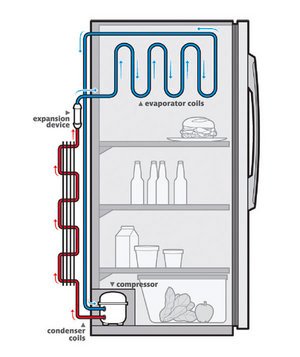The domestic refrigerator works based on Vapor compression refrigeration cycle.
Note:
- Whenever a liquid evaporates, it absorbs heat.
- Similarly whenever a liquid condenses, it releases heat.
Below is the schematic diagram

Image source: Araner.com
The basic components are
Refrigerant - a fluid that carries away heat from the refrigerator by evaporation and dissipates heat to the surroundings by condensation. Modern refrigerators usually use a refrigerant called HFC-134a, which has a boiling point of -26.3 deg Celcius at atmospheric pressure.
Evaporator - It consists of coils, through which, a low-pressure and low-temperature refrigerant enters and gets evaporated, which absorb heat from the place to be cooled(freezer).
Compressor - It continuously sucks out the gaseous refrigerant from the evaporator and compresses it further to high-pressure and high-temperature refrigerant. A compressor is driven by the electric motor that requires electricity to operate.
Condenser - It consists of the thin copper tubes which usually located at the backside of the refrigerator. The high-pressure and high-temperature refrigerant from the compressor enters the condenser where it is cooled by atmospheric air. Thus heat absorbed by the refrigerant in the evaporator loses its heat in the condenser.
Expansion Valve -The refrigerant from the condenser enters the expansion valve which is made up of a number of turns of thin copper tubing. The expansion valve removes pressure and temperature from the refrigerant. The refrigerant is again sent back to the evaporator and the cycle continues.

Image source: realsimple.com
If you liked the article, kindly upvote. If you have any doubts and suggestions, kindly comment below.